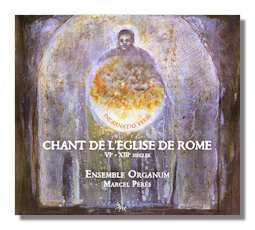
The Internet's Premier Classical Music Source
Related Links
- Latest Reviews
- More Reviews
-
By Composer
-
Collections
DVD & Blu-ray
Books
Concert Reviews
Articles/Interviews
Software
Audio
Search Amazon
Recommended Links
Site News
 CD Review
CD Review
Incarnatio Verbi

Chant de l'eglise de Rome
(Old Roman Chant)
- Messe de la vigile
- Messe de minuit
- Messe de l'aurore
- Messe du jour
Ensemble Organum/Marcel Pérès
Zig-Zag Territoires ZZT081001
The seven members of Ensemble Organum, renowned for outstanding work in this area of early music, make an breathy, earthy, indeed a very down-to-earth sound. Their chant is neither saccharine nor sanitized. It's not the sweet and shining later plainchant of other vocal milieus. It has guts, vibrancy and masculine vigor. The present recording is also shot through with the fervor associated with a special occasion for the Christian church: the longest night of the year.
The winter solstice, to which the early Christians attached Christmas, occasions a special sequence, a cycle of four masses, which is interspersed almost uninterrupted with the usual Offices for that night. Eighteen hours (six light and twelve dark) pass between Nones (the ninth hour, when the sun is midway between its zenith and twilight) through to Terce (when it's between the horizon and its zenith again). During what Ensemble Organum's director, Marcel Pérès, in his short but highly informative essay calls the "geometry of time" (sensitivity to which we have largely lost), the central mystery of the Christian faith, the Incarnation of the Word, is celebrated; as it has annually been celebrated for centuries. Indeed, it was sung presumably without interruption from its inception (in the sixth century and re-inforced by the scholars – and politicians! – of Carolingian Renaissance from the late eighth century) until the Schism of the thirteenth century.
Not until after a gap of seven hundred years, in the early twentieth century, was much interest again taken in the ceremony and its music. And only a further 50 years after that was its musicology really addressed. Then the term "Old Roman Chant" was used to distinguish its musical style (if not the liturgical significance) from the Gregorian. The former is more positively and explicitly ornamented (we hear, and revel in, that throughout this recording), whilst Gregorian chant usually merely implies (minimum) ornamentation.
The music we hear on this excellent and thoroughly recommendable CD owes as much, then, to the Graeco-Byzantine tradition (as mediated by the Rome) as it does to the more familiar, smoother and perhaps initially more euphonic (because simpler and more "rounded") plainchant. The music here quivers with raw power, yet is never over-sung. One, two or three soloists sing each section. This creates and sustains a personal realm in which to absorb (by reading them) the charged text as sound: the texts are printed in Latin, English, and French. It's sound that floats, ascends, descends, twists and repeats in melody, with varying degrees of angularity and calm; sound which embosses, illuminates, shadows and hints with equally varied textures. Such is the majesty and intimacy combined of the words and music.
This recording includes both Propers and Ordinaries from a manuscript dating from 1071 kept in the collection of the Fondation Martin Bodmer at Cologny in Geneva. Necessarily it is not the whole of each Mass. Of such beauty, clarity and impact is the music, though, that one hopes to get it all eventually from these expert and distinguished musicians. For one of their great strengths is to convey the atmosphere, the declamatory and proclamatory nature of the music as well as its devotional import. And at the same time to sound neither pompous nor distant, nor to lose the immediacy of the sound (text with music) in either spectacular excess or spurious indulgence. It's plain sparkling water, not champagne. But the effervescence is strong.
Indeed, the spiritual weight is offered to the listener as a weight which they can carry and know, rather than throw about or drop. But weight there is. And, although one starts by being conscious of every intricately articulated syllable and phrase, these soon homogenize into a more digestible experience as the architecture of the music becomes clearer and clearer; and as anticipation takes over from any anxiety originally felt because of the initial rawness of Ensemble Organum's sound.
In that, again as Pérès writes, "Old Roman chant occupies a central position in the history of music. It is the keystone which gives meaning and coherence to what ought to be the musical consciousness of Western Europe and far beyond", the music on this CD is important also because it is from a tradition now all but lost. All credit to Zig-Zag Territoires for commissioning, seeing through and promoting such moving, lovely and historically important repertoire. Thoroughly recommended.
Copyright © 2009, Mark Sealey





















